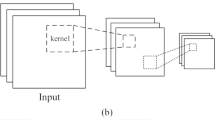Abstract
DC–DC converters are the devices which can convert a certain electrical voltage to another level of electrical voltage. They are very popularly used because of the high efficiency and small size. This paper proposes an intelligent power controller for the DC–DC converters via cerebella model articulation controller (CMAC) neural network approach. The proposed intelligent power controller is composed of a CMAC neural controller and a robust controller. The CMAC neural controller uses a CMAC neural network to online mimic an ideal controller, and the robust controller is designed to achieve L 2 tracking performance with desired attenuation level. Finally, a comparison among a PI control, adaptive neural control and the proposed intelligent power control is made. The experimental results are provided to demonstrate the proposed intelligent power controller can cope with the input voltage and load resistance variations to ensure the stability while providing fast transient response and simple computation.












Similar content being viewed by others
References
Pressman AI (1998) Switching power supply design. McGraw-Hill, New York
Alvarez-Ramirez J, Cervantes I, Espinosa-Perez G, Maya P, Morales A (2001) A stable design of PI control for DC–DC converters with an RHS zero. IEEE Trans Circuits Syst I 48(1):103–106
Mazumder SK, Nayfeh AH, Borojevic D (2002) Robust control of parallel DC–DC buck converters by combining integral-variable-structure and multiple-sliding-surface control schemes. IEEE Trans Power Electron 17(3):428–437
Lopez M, Vicuna LG, Castilla M, Gaya P, Lopez O (2004) Current distribution control design for paralleled DC/DC converters using sliding-mode control. IEEE Trans Ind Electron 51(2):419–428
Viswanathan K, Oruganti R, Srinivasan D (2005) Nonlinear function controller: a simple alternative to fuzzy logic controller for a power electronic converter. IEEE Trans Ind Electron 52(5):1439–1448
He D, Nelms RM (2005) Fuzzy logic average current-mode control for DC–DC converters using an inexpensive 8-bit microcontroller. IEEE Trans Ind Appl 41(6):1531–1538
Rubaai A, Ofoli AR, Burge L, Garuba M (2005) Hardware implementation of an adaptive network-based fuzzy controller for DC–DC converters. IEEE Trans Ind Appl 41(6):1557–1565
Hsu CF, Lin CM, Cheng KH (2006) Supervisory intelligent control system design for forward DC–DC converters. IEE Proc Electr Power Appl 153(5):691–701
Cheng KH, Hsu CF, Lin CM, Lee TT, Li C (2007) Fuzzy-neural sliding-mode control for DC–DC converters using asymmetric Gaussian membership functions. IEEE Trans Ind Electron 54(3):1528–1536
Hsu CF, Lin CM, Chen TY (2005) Neural-network-identification-based adaptive control of wing rock motion. IEE Proc Control Theory Appl 152(1):65–71
Duarte-Mermoud MA, Suarez AM, Bassi DF (2005) Multivariable predictive control of a pressurized tank using neural networks. Neural Comput Appl 15(1):18–25
Leu YG, Wang WY, Lee TT (2005) Observer-based direct adaptive fuzzy-neural control for nonaffine nonlinear systems. IEEE Trans Neural Netw 16(4):853–861
Hsu CF, Lin CM, Lee TT (2006) Wavelet adaptive backstepping control for a class of nonlinear systems. IEEE Trans Neural Netw 17(5):1175–1183
Hsu CF (2007) Self-organizing adaptive fuzzy neural control for a class of nonlinear systems. IEEE Trans Neural Netw 18(4):1232–1241
Peng YF, Wai RJ, Lin CM (2004) Implementation of LLCC-resonant driving circuit and adaptive CMAC neural network control for linear piezoelectric ceramic motor. IEEE Trans Ind Electron 51(1):35–48
Lin CM and Peng YF (2004) Adaptive CMAC-based supervisory control for uncertain nonlinear systems. IEEE Trans Syst Man Cybern B Cybern 34(2):1248–1260
Chen JY, Tsai PS, Wong CC (2005) Adaptive design of a fuzzy cerebellar model arithmetic controller neural network. IEE Proc Control Theory Appl 152(2):133–137
Lin CM, Chen CH (2006) Adaptive RCMAC sliding mode control for uncertain nonlinear systems. Neural Comput Appl 15(1):253–267
Wu TF, Tsai PS, Chang FR, Wang LS (2006) Adaptive fuzzy CMAC control for a class of nonlinear systems with smooth compensation. IEE Proc Control Theory Appl 153(6):647–657
Lane SH, Handelman DA, Gelfand JJ (1992) Theory and development of higher-order CMAC neural networks. IEEE Control Syst Mag 12(2):23–30
Su SF, Lee ZJ, Wang YP (2006) Robust and fast learning for fuzzy cerebellar model articulation controllers. IEEE Trans Syst Man Cybern B Cybern 36(1):203–208
Slotine JJE, Li WP (1991) Applied nonlinear control. Prentice-Hall, Englewood Cliffs
Wang WY, Chan ML, Hsu CCJ, Lee TT (2002) H ∞ tracking-based sliding mode control for uncertain nonlinear systems via an adaptive fuzzy-neural approach. IEEE Trans Syst Man Cybern B Cybern 32(4):483–492
Lin CM, Peng YF, Hsu CF (2004) Robust cerebellar model articulation controller design for unknown nonlinear systems. IEEE Trans Circuits Syst II 51(7):354–358
Lee TS, Lin CH, Lin FJ (2005) An adaptive H ∞ controller design for permanent magnet synchronous motor drives. Control Eng Pract 13(4):425–439
Acknowledgments
The authors appreciate the partial financial support from the National Science Council of Republic of China under grant NSC 96-2218-E-216-001. The authors would like to express their gratitude to the Reviewers for their valuable comments and suggestions.
Author information
Authors and Affiliations
Corresponding author
Rights and permissions
About this article
Cite this article
Hsu, CF. Design of intelligent power controller for DC–DC converters using CMAC neural network. Neural Comput & Applic 18, 93–103 (2009). https://doi.org/10.1007/s00521-007-0161-3
Received:
Accepted:
Published:
Issue Date:
DOI: https://doi.org/10.1007/s00521-007-0161-3




